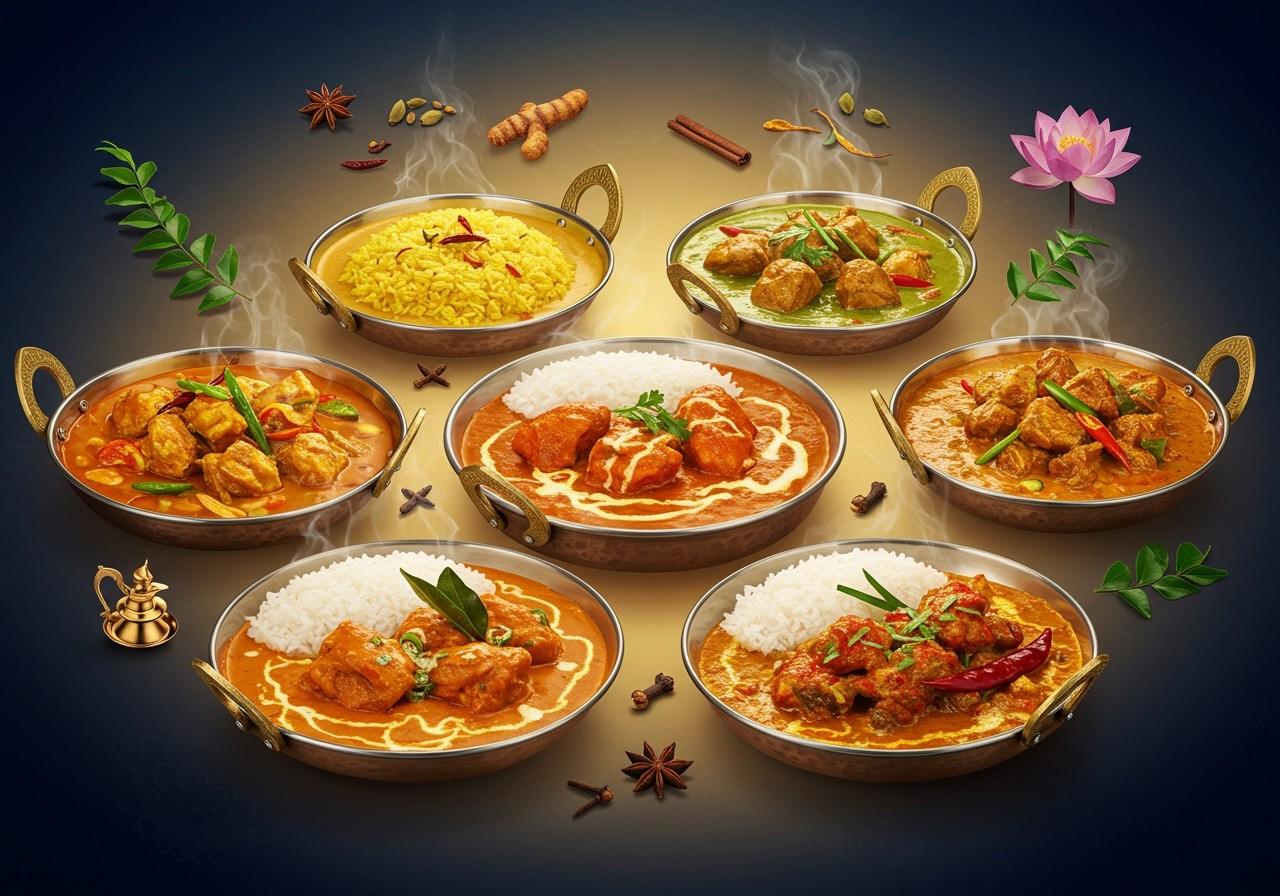
Curry, a globally loved dish, comes in a vast array of variations. Each curry boasts a unique history, specific ingredients, and a distinctive regional twist. Contrary to the misconception of a single recipe, the world of curry extends far beyond, encompassing types like bhuna, madras, vindaloo, dal makhani, sambar, kadhi, chicken stew, macher jhol, and pork vindaloo. The spectrum of curry flavors ranges from mild to fiery, catering to diverse palates and preferences.
Origins of Curry
The word “curry” originates from the Tamil word ‘kari,’ meaning sauce. Ancient Indian texts and archaeological findings reveal the historical use of spices and cooking methods that resemble contemporary curries. The spice trade significantly contributed to the global spread of curry.
British colonization played a key role in introducing and popularizing curry in the West. Within India, regional variations are prominent. From the rich, creamy curries of the north to the fiery, coconut milk-infused curries of the south, curry holds profound cultural significance in Indian traditions, rituals, and celebrations.
Curry in South Asia
South Asia presents a diverse tapestry of curries, each with distinct flavors and cultural contexts.
- India: Offers a wide spectrum, from Punjabi butter chicken to Bengali fish curry and Goan vindaloo.
- Pakistan: Features curries like Nihari and Karahi, incorporating slow-cooked meats and bold spices.
- Sri Lanka: Showcases curries like Kottu Roti and Fish Ambul Thiyal, often prepared with coconut milk and fresh herbs.
- Bangladesh: Favors fish and mustard-based curries such as Ilish Bhapa.
- Nepal: Highlights dal bhat, a lentil-based curry, as a staple meal.
Curry in Southeast Asia
Southeast Asian curries are renowned for their unique ingredients and cooking techniques.
- Thailand: Offers iconic dishes like green curry (kaeng khiao wan) and massaman curry, balancing sweet, sour, and spicy flavors.
- Malaysia: Presents diverse influences, ranging from roti canai with dhal to Malay rendang.
- Indonesia: Is known for beef rendang and gulai, both of which use coconut milk as a base.
- Vietnam: Features curries like cà ri gà with fresh herbs and spices.
- Philippines: Offers kare-kare, a unique peanut-based oxtail curry.
Curry in East Asia
East Asian cuisines have uniquely adapted curry to their culinary landscape.
- Japan: Features kare raisu (curry rice), a mild and slightly sweet curry often served with rice and pickled vegetables, introduced during the Meiji era.
- China: Offers variations like Sichuan curry (spicy) and Cantonese curry (milder), incorporating local ingredients.
- Korea: Includes curry tteokbokki (spicy rice cakes) and curry ramyeon (instant noodles).
Curry in the Caribbean
Caribbean curry traditions reflect a blend of African, Indian, and European influences. Indian indentured laborers introduced curry to the region in the 19th century.
- Trinidad and Tobago: Are famous for curried goat and roti, a flatbread served with various curries.
- Jamaica: Uses allspice and Scotch bonnet peppers in dishes like curried chicken and curried goat.
- Guyana: Often incorporates local ingredients like cassava and plantains in its curries.
Curry in Africa
Africa displays diverse curry traditions influenced by Indian, Middle Eastern, and European cuisines. Indian migration introduced curry to East Africa.
- South Africa: Cape Malay cuisine features aromatic curries like bobotie and denningvleis.
- West Africa: Offers unique curries such as Ghanaian groundnut stew and Nigerian ofada stew.
- North Africa: Its curries show influences from Middle Eastern spices and cooking techniques.
Get Your Authentic Indian Spices from Poojn.in
Looking to create authentic curries from around the globe? Poojn.in offers a premium selection of Indian spices, essential for capturing those authentic flavors. Our carefully curated collection includes:
- Pure Green Cardamom (Elaichi): A staple in Indian, Middle Eastern, and Thai curries, adding a distinct aromatic sweetness.
- Organic Turmeric Powder: The cornerstone of most curry dishes, providing both vibrant color and earthy flavor. It also offers various health benefits.
- Whole Black Peppercorns: Essential for tempering curries across various cuisines, adding a pungent depth.
- Cumin Seeds (Jeera): A ubiquitous spice in curry preparations worldwide, contributing a warm, earthy note.
- Coriander Seeds (Dhania): A crucial component of many curry powder blends, imparting a citrusy and slightly sweet flavor.
All spices available at Poojn.in are:
- Sourced directly from trusted farmers: Ensuring high quality and freshness.
- Packed in airtight containers to maintain freshness: Preserving the aroma and flavor of the spices.
- Available for pan-India delivery: Conveniently delivered to your doorstep.
- Quality checked and certified: Meeting stringent quality standards.
- Competitively priced: Offering great value for your money.
Visit Poojn.in or contact our customer service to order these authentic Indian spices for your global curry explorations. We offer secure payment options and swift delivery across India. [Note: Product availability and prices may vary. Please check the website for current stock and rates.]
For those seeking turmeric, we highly recommend our Pure Pik Whole Turmeric Sticks. If you need camphor for your rituals, consider our Ganesh Brand Best Camphor Cubes.
Conclusion: A World United by Curry
Curry transcends mere sustenance; it embodies a celebration of history, culture, and community. From its ancient Indian roots to its diverse global adaptations, curry unites people through its rich flavors and shared culinary heritage. Each region adds its unique touch, creating a vibrant tapestry of tastes that reflect its heritage.
Whether you enjoy a creamy North Indian curry, a spicy Thai green curry, or a fragrant Caribbean goat curry, appreciate the rich history and cultural significance woven into each dish. Embrace the convenience of online shopping for authentic ingredients at Poojn.in and experience the joy of preparing and sharing these cherished meals.


